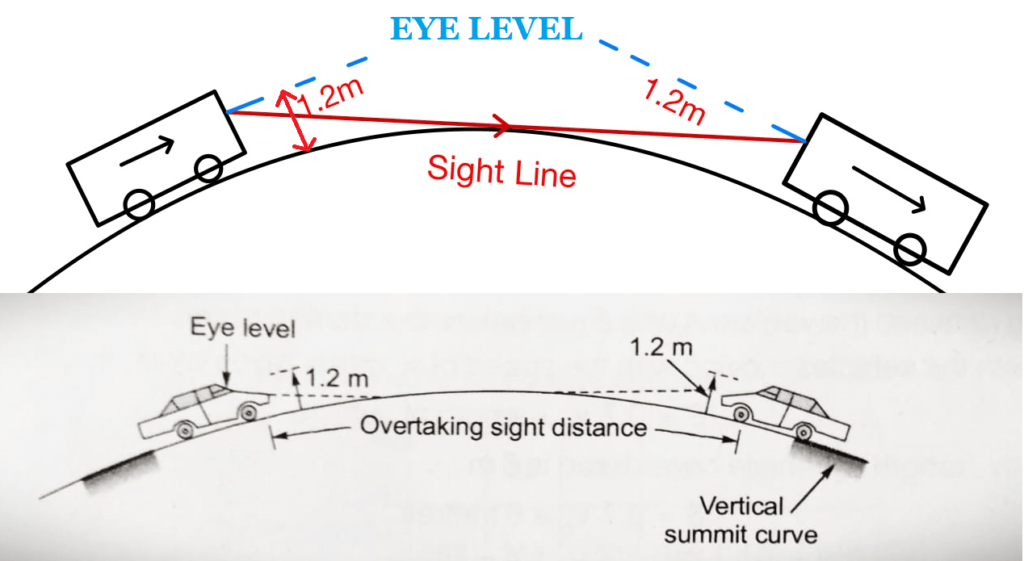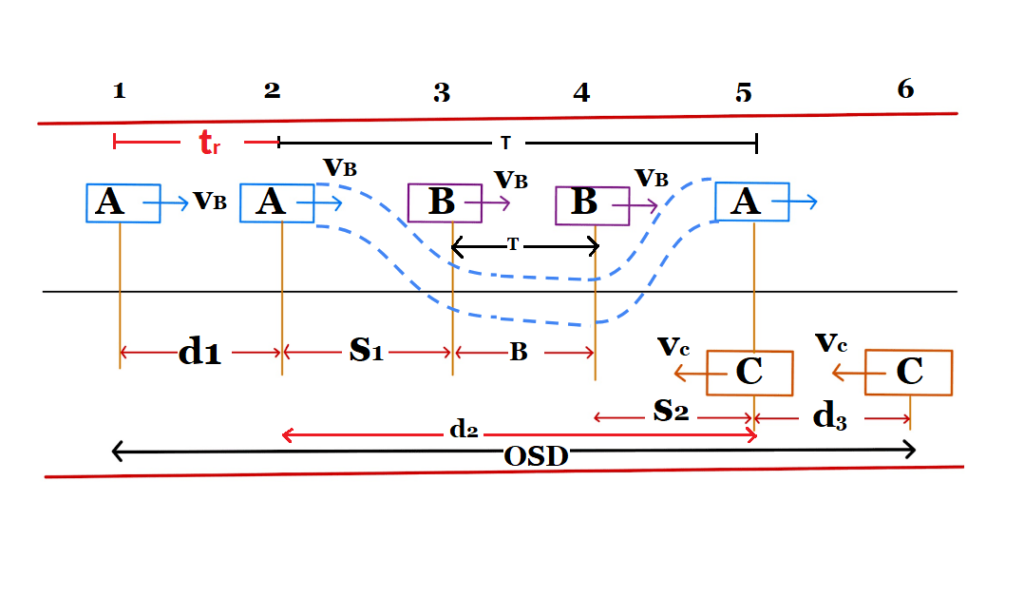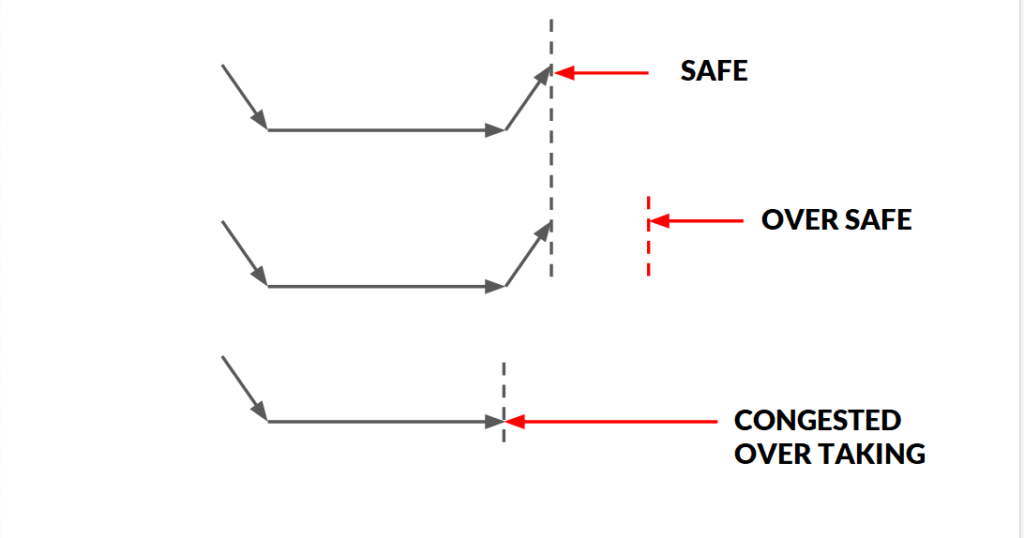Overtaking Sight Distance (OSD):
Note: This topic is part of the second chapter of Highway Engineering. I suggest reading this topic in the context of the complete chapter: Geometric Design of Highway. If you want to read the entire Highway Engineering, click here: Highway Engineering.
- If all the vehicle ply on the road at the design is speed, then theoretically there would be no need for overtaking, but practically it never happens, hence vehicle moving at design speed, has to overtaken the slow moving vehicle.
- The minimum distance open to the vision of the driver of a vehicle intending to overtake slow moving vehicle with safety against traffic in opposite direction is term as OSD or “Safe Passing Sight Distance”.
- OSD is measured along center line of the road considering the eye level of driver at 1.2 m above the surface, observing the object at height of 1.2 m above the surface.

Factors effecting OSD
- Speed of vehicle , Overtaking vehicle, Overtaken vehicle, The vehicle coming from the opposite direction.
- Reaction time and skill of driver.
- Gradient of Road.
- Condition of overtaken vehicle which governs the rate acceleration.
- Distance between the two vehicle.
Analysis of OSD:

The overtaking moment maybe split up into three operation as follows:
- d1:- It is the distance travelled by overtaking vehicle “A” during that reaction time “tr” of the driver, before starting to overtake vehicle B at speed of \(V_B\).
- d2:- it is the distance travelled by vehicle “A”during the actual overtaking operation of time “T”.
- d3:- It is the distance travelled by an oncoming vehicle “C” during the actual overtaking operation of a for time “T”.

Assumption in analysis of OSD
- Overtaking vehicle is forced to reduce speed up to the speed of overtaken vehicle for reaction time.
- When the driver of vehicle “A” find sufficient clear gap, decide within a reaction time to overtake.
- The vehicle “A” accelerated and overtakes the vehicle “B” within a distance d2 during the time “T”.
- The distance d2 is split in components.
- During this overtaking time “T” the vehicle “C” coming from opposite direction travel through distance d3.
case.1
As per IRC reaction time is taken to be 2.0 second for OSD.
case.2
d2= s1+s2+B.
s1 or s2= minimum spacing between the two vehicle, which depends upon their speed. It is also termed as space headway. but for design s1=s2=s (s1+s2= 2s).
d2= 2s +B.
Space Headways
s = (0.7×vb +6) m. | vB put in metre/second. |
s= (0.7×0.278×vb +6) m. | |
s= (0.2×vb +6) m. | vB put in kilometre/hours. |
| B= Distance traveled by vehicle ‘B’ of speed vb and time ‘T’. | |
B= vb·T (metre) | vB put in metre/second. |
B= 0.278×vb×T (metre) | vB put in metre/second. |
Here
The acceleration of overtaking vehicle varies depending on several factor:
- Type of vehicle.
- Condition of vehicles (for new vehicle acceleration is high and old vehicle acceleration is low.)
- Load on vehicle.
- Speed of vehicle.
- Characteristic of driver.
Maximum overtaking acceleration at different speeds are as follows:
| SPEED (KM/H) | MAXIMUM ACCELERATION (M/SEC2) |
| 25 | 1.41 |
| 30 | 1.30 |
| 40 | 1.24 |
| 50 | 1.11 |
| 65 | 0.92 |
| 80 | 0.72 |
| 100 | 0.53 |
Note:- Overtaking time “T” of the vehicle A depends upon it average acceleration “a” & speed of overtaken vehicle vb.
case.3
OSD= d1 + d2 + d3 metres.
OSD= vb·tr + vbT+ 2s+ vcT metres. | |
| vb and vc in m/s, tr and T in sec | |
| OSD= 0.278vbtr +0.278vbT+ 2s+ 0.278vcT metres. | |
| vb and vc in km/h, tr and T in sec | |
NOTE:
- If vb value is not given, then assume:
vb = vc– 4.5m/sec | vb & vc in m/sec. |
vb = vc– 16kmph | vb & vc in kmph. |
vc =design speed of road.
- On divided Highways with one way traffic the overtaking distance need to be only (d1 + d2) because no one expected from the opposite direction.(On divided highways, d3 need not be considered)
- On divided highways with four or more lanes, IRC suggests that it is not necessary to provide the OSD, but only SSD is sufficient.
The value of overtaking sight distance recommended by IRC are given as:
| Speed(kmph) | Safe Overtaking Sight Distance (metres) |
| 40 | 165 |
| 50 | 235 |
| 60 | 300 |
| 65 | 340 |
| 80 | 470 |
| 100 | 640 |
Effect of Gradient on Overtaking Sight Distance
- On an ascending gradient, the overtaking sight distance required is more due to reduced acceleration of overtaking vehicle and vehicle coming from opposite direction is likely to speed up. Effect of gradient is compensated by reducing the speed of overtaken vehicle.
Overtaking zones
Overtaking zones are provided when OSD cannot be provided throughout the length of the highway. These are zones dedicated for overtaking operation, marked with wide roads. The desirable length of overtaking zones is 5 time OSD and the minimum is 3 times OSD.

For Detailed Analysis of Highway Engineering Step By Step.